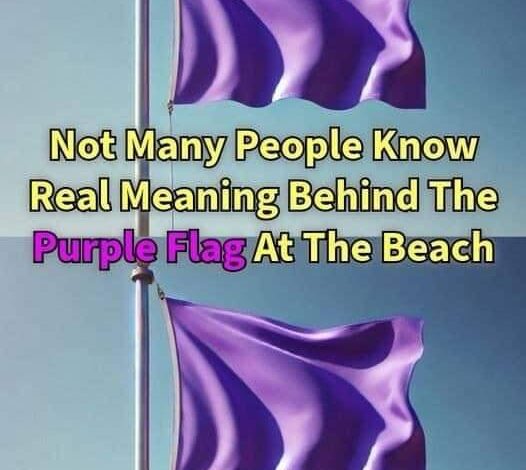The Meaning of a Purple Flag at the Beach

I’ve spent endless hours playing in the waves, making sandcastles, and lounging in the sun because I genuinely love the beach season. The sensation of sand between your toes, the sound of breaking waves, and the salty breeze all have a certain allure that makes you feel incredibly happy. But in the middle of all the excitement, I recently discovered the mysterious purple flag, a puzzle I had never solved before.
The bright green indicates calm and safe waters, the blazing red signals strong currents, and even the sunny yellow warns us to exercise caution. We are all familiar with the beach’s flag language. For beachgoers like me who enjoy swimming in the wide blue ocean, each color has a story to tell and an important piece of knowledge. However, what exactly does purple represent? It’s not just any flag, so be ready to be taken aback, as I was.
Imagine yourself standing on the seashore, preparing to jump into the surf on a great beach day. The sun is bright, the waves are soft, and everything appears to be in balance. Your gaze moves across the well-known flags, gauging the mood of the sea. Green: peaceful conditions with little hazards. Verify. Yellow indicates a medium level of danger; exercise some caution. I understand. Red: There is a high risk and rough seas coming. No issue, I’m an experienced beachgoer who is aware of my boundaries. The purple flag, however, is there, fluttering in the wind like a puzzle that needs to be solved.
I became curious and set out to figure out the meaning of this enigmatic flag. And I discovered something that was both shocking and instructive. The sea itself is alerting us to the existence of marine pests with the purple flag, which is more than just another warning. Imagine that the ocean is using a single color to communicate with us and keep us safe while we are in its embrace.
You say marine pests? Yes, you read correctly. The purple flag serves as a warning about possible underwater companions, much like a lighthouse. We may be sharing the ocean with those ethereal but occasionally stinging jellyfish. Not only that, but stingrays and other harmful creatures might be hiding beneath the surface. All of a sudden, the significance of that purple flag increases significantly.
Therefore, don’t simply write off that mysterious purple flag as just another beach decoration the next time you see it. The ocean itself is sending out a signal, a warning that underneath its glittering surface is a world full of potential dangers as well as beauty. It is our duty as beachgoers to pay attention to this advice and modify our plans as necessary.

Do you recall the other flags? Green indicates calm waters, making it the ideal color for a leisurely swim. The waters are still attractive, but a little more caution may be necessary due to the yellow warning of moderate dangers. Conversely, red denotes a more significant warning. In high-hazard, difficult circumstances, the waves are a little too erratic to swim comfortably. A double red flag, which is a red line drawn for your safety, is also an obvious indication that the water is off-limits.
The purple flag, though? “Hey, there might be some uninvited guests in the water today,” the ocean is saying. It offers us an opportunity to understand the complex balance of the ocean ecosystem and serves as a lesson in coexistence.
Therefore, my fellow beachgoers, the purple flag is now a symbol of maritime communication rather than a mystery. You will therefore understand that the sea is saying, “Welcome, but be aware,” the next time you visit your favorite beach and notice that intriguing purple flag. Let’s embrace the ocean’s message, respect its residents, and continue to enjoy the waves with a greater knowledge.